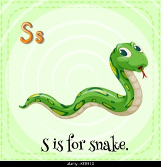
Miss Watson's Reading Lessons
Spring 2022 Lesson Designs
Emergent Literacy Design:
"Slippery Slimy Snake"

Rationale: This lesson will help children identify /s/, the phoneme represented by S. Students will be able to recognize /s/ in words, while applying words by learning a sound analogy (that’s a slippery slope!). Students will be able to recognize the letter symbol S, practice finding /s/ words, and apply phoneme awareness with /s/ in phonetic cue reading by distinguishing rhyming words from beginning letters.
Materials:
-
Primary paper and pencil
-
Chart with “Sally’s silly snake is slimy”
-
Drawing paper and crayons
-
Assessment worksheet identifying /s/ and writing S.
-
Word cards with (SNAKE, LAKE) (SMOOTH, BOOTH) (SCALES, PALE) (SLIP, CLAP)
-
The book “Sally the Snake” by Eric Wood
Procedures:
-
Say: Our written language is a secret code. The tricky part is learning what letters stand for- the mouth moves as we say words. Today we are going to learn about spotting the mouth move /s/. The sound of /s/ is spelled with the letter S. /s/ is a sound we make when we talk about slippery slimy snakes.
-
Let’s pretend to slither along like a snake, /s/, /s/, /s/. [Pantomime slithering hands] Notice how your mouth moves and where your tongue is. [touching the roof of your mouth]. When we pronounce the sound /s/ that the letter s makes, we blow air out of our mouth while the tongue is at the roof of the mouth. This produces the /s/ sound.
-
Let me show you how to find the /s/ in the word test. I am going to slowly say the word test in a super slow motion, and you must listen for the slippery snake. Tt-ee-ss-t. Slower: Ttt-e-e-e-sss-t. Did you hear it? I felt my tongue touch the roof of my mouth and air blows out. Slippery snake /s/ is in test.
-
Let’s try a tongue tickler [on chart]. Sally’s silly snake is slimy. Everyone says it four times together. Now say it again, and this time, stretch the /s/ at the beginning of the words. “Sssally’ ssilly ssnake isss sslimy.” Try it again, but this time break it off the word: /s/ally’s /s/illy /s/nake i/s/ /s/limy.”
-
[Provide/have the student take out primary paper.] We use letter S to spell /s/. Capital S looks like a snake with its head raised. [draw a picture on the board of this motion] Now let’s write the lower-case letter s. Start just below the fence. Start to make a little curl, like a lower-case c, then make another curl, like a lower-case c but this time it’s backwards. [slowing draw this out on board] I am going to walk around and look at everyone’s s. Raise your hand once you have completed this, and if I check you off make six more like it.
-
Ask students to raise their hand and tell you how they know what word has the /s/: Do you hear /s/ in soon or moon? Swing or thing? Loss or talk? Class or bat?
-
Say: “Let’s look at our book about Sally the snake. Read pages 1-5 drawing out the /s/ from each page. Ask them if they can think of any other words with /s/ after the reading is complete. Ask them to draw a silly creature, like a snake with five heads, and come up with a name starting with /s/. Have each student write the name under the picture they drew. Display their work, so they feel accomplished.
-
Show the word cards and have children distinguish if they hear the /s/ between the two words given.
-
For the assessment, pass out the worksheet to the students. Have students practice an upper case and a lower-case S four more times at the top of the worksheet. Have the student color the pictures below that start with /s/. Allow time for students to work on this, then call each student up to read the phonetic cue words from step 8.
References:
https://sydneyfaith1.wixsite.com/my-site/emergent-literacy
https://samanthaeason1999.wixsite.com/mysite/emergent-literacy-design
https://ansleychristensen.wixsite.com/lesson-designs/growing-fluency-design
https://wp.auburn.edu/rdggenie/
Assessment sheet: https://free4classrooms.com/free-beginning-sounds-worksheet-letter-s/